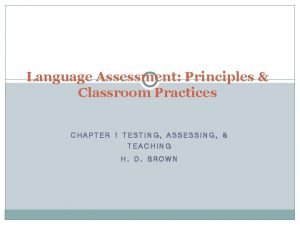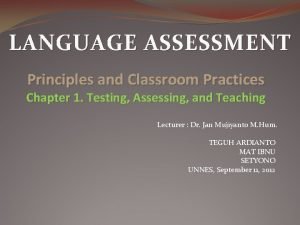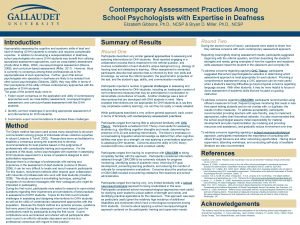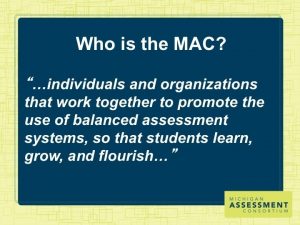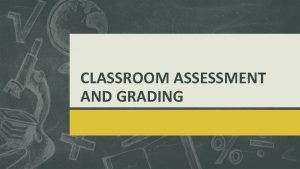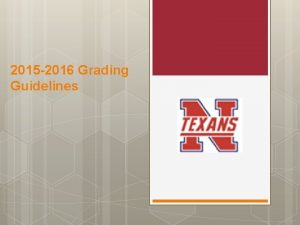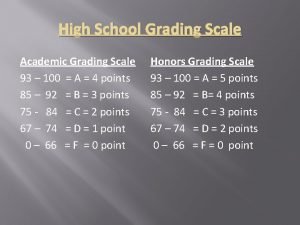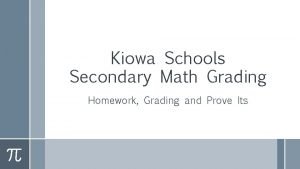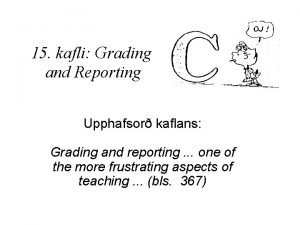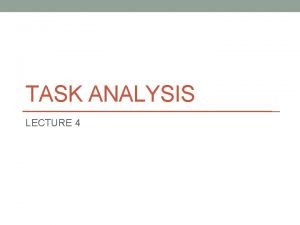Assessment for Learning Grading Practices History of Grading











































































- Slides: 75

Assessment for Learning: Grading Practices

History of Grading Passage of compulsory school attendance laws; rapid increase in high school enrollment; migration to US and cities; Industrial Revolution & William Farish (paid based on # of students) Elementary – narrative High School – introduce use of percentages to certify student work in specific subjects Grading and reporting virtually unknown in US schools -one room schoolhouse -few students go beyond elementary -oral reporting to parents Before 1850 Late 1800 s Schools begin grouping students in grade levels by age -More formal progress evaluations but in narrative form 1870 1912 Grading software and online grade books gain in popularity percentages Two Wisconsin researchers (Starch & Elliott) challenge reliability & accuracy of percentage grades 1918 1930 Teachers move away from percentages to scales with fewer, larger categories – 3, 2, 1 Excellent, Average, Poor 1990

“. . . (grading) practices are not the result of careful thought or sound evidence, . . . rather, they are used because teachers experienced these practices as students and, having little training or experience with other options, continue their use. ” Guskey, Thomas R. (Editor), Communicating Student Learning: The 1996 ASCD Yearbook, ASCD, Alexandria, VA, 1996, 20

Take a moment to…. Describe to a partner your training on grading practices during your teacher training program and/or any other professional development on this topic. Be honest – there is no judging.

Critical Question How confident are you that the grades students receive in your school are: Accurate? Consistent? Meaningful? Supportive of learning? (On your own, complete the assessment at your table. )

Table Discussion • Discuss your assessment with your table mates. • What do grades currently mean? What do they represent? • What feedback messages do grades currently convey to parents? To students? To teachers?

Why do we assign grades to students’ work? Why do we use report cards?

• • • Six broad categories (Guskey & Bailey 2010) To communicate information about students’ achievement in school to parents and others. To provide information to students for self- evaluation. To select, identify or group students for certain educational paths or programs. To provide incentives for students to learn. To evaluate the effectiveness of the instructional programs.

Simple Truth There is no single reporting instrument that can serve all of these purposes well.

So…. let’s talk about

Essential Beginning Steps 1. Clarify the purpose of grades and grading in every classroom, every school. 1. Align policies and practices with the purpose. Form follows purpose. 3. Ensure proposed changes are supported by strong research evidence.

Guiding Questions • What information will be communicated in the report card? • Who is the primary audience for the information? • What is the intended goal of the communication? How should the information be used?

To remain competitive in a global, continuously evolving, complex, technologically sophisticated world, we need high levels of learning for all students.

To reduce the failure rate, schools don’t need a new curriculum, a new administration, new teachers or new technology. They just need a better grading system. -Doug Reeves

Why would anyone want to change current grading practices? Simple answer – Grades are so imprecise that they are almost meaningless. Robert Marzano

Calculate the student’s grade: Ten assignments: C B NTI (not turned in) D C B NTI C A

Which grading method is best? Which is fairest? What grade does each student deserve? Average Score - simple arithmetic average of unit scores Median Score – middle score of the five unit scores Deleting Lowest – the arithmetic average after deleting the lowest score in the group

Consider this: Student 1 struggled in the early part of the marking period but continued to work hard, improved in each unit, and did excellently in unit 5. Student 2 began with excellent performance in unit 1 but then lost motivation, declined steadily during the marking period, and received a failing mark for unit 5. Student 3 performed steadily throughout the marking period, receiving three B’s and two C’s, all near the B – C cut-score. Student 4 began the marking period poorly, failing the first two units, but with newfound interest performed excellently in units 3, 4, and 5. Student 5 began the marking period excellently, but then lost interest and failed the last two units. Student 6 skipped school (unexcused absence) during the first unit, but performed excellently in every other unit. Student 7 performed excellently in the first four units, but was caught cheating on the assessment for unit 5, resulting in a score of zero for that unit.

• All three approaches are mathematically precise. • Not one student would receive the same grade across all three methods. • Which of the method is fairest? • Which method provides the most accurate summary of each student’s achievement and performance? • Do all 7 students deserve the same grade? • Are there defensible reasons to justify different grades for different students? • Can they be fairly and equitably applied? • Can these reasons be clearly communicated to students before instruction begins? • Is it fair to apply them if they were not communicated to students?

Use of Percentage Grades 0 10 20 30 40 50 60 70 80 90 100 Failure Passing Give the illusion of precision to imprecise and often highly subjective judgment of students’ performance Two thirds of the designated levels describe failure, implying the degrees of failure can be more finely distinguished than degrees of success. Zeros in a percentage grading system have a devastating effect on a student’s percentage grade (minimum of 9 perfect papers). Guskey, 2004; Reeves, 2004

Computerized grading programs don’t make the grading process any more fairer or objective. In fact, these programs ignore several potentially harmful grading practices: Averaging scores to determine grade Use of zeros ‘Big project’ buster

“Toxic Grading Practices" Doug Reeves


The Use of Zeros for Missing Work? “. . . the appropriate consequence for failing to complete an assignment is to require the student to complete the assignment. That is, students lose privileges—free time and unstructured class or study-hall time—and are required to complete the assignment. ” -“The Case Against Zero”, Doug Reeves, 2004 What about eliminating this practice seems most daunting to you? Discuss with a partner.

Get Rid of the Average! What information provides the most accurate depiction of students’ learning at this time? …. averaging assumes that no learning has occurred from assessment to assessment (Marzano 2006) Relying on past assessment data miscommunicates students’ achievement. (Stiggins & Chappuis, 2011) Alternative to Averaging: • Give priority to the most recent evidence. • Give priority to the most comprehensive evidence. • Give priority to evidence related to the most important learning goal or standards.

Alternative to Percentages • Use an integer grading system of 0 -4 • Improving failing grade to passing means moving from 0 to 1…recovery is possible Below Basic, Proficient, Advanced • Incorporate training to clarify evidence needed in each category

More Toxic Practices • Lowering grade because of behavior • Pattern of assign, test, grade & teach • Grading first efforts/don’t penalize practice & risk taking • Use of extra credit or bonus points • Use of group scores in individual grades • Grading on a curve

Don’t Despair! Don’t Give Up! As strong, smart instructional leaders, we can engage in these tough conversations!!! Building knowledge around effective grading practices is a PROCESS!!!! It’s up to us to take action! The alternative is THIS!!

Review and Reflection • Why is it important to identify the purpose of grading? • Reflecting on the information earlier in the presentation, would you consider any changes to your current grading practices? Why not?

So…. . What does the research say… • Grading and reporting aren’t essential to instruction. • No one method of grading and reporting serves all purposes well. • Regardless of method used, grading and reporting remain inherently subjective. • Grades have some value as rewards, but no value as punishments. • Grading and reporting should always be done in reference to learning criteria, never on the curve. Thomas Guskey 1994

What we know about research on grading #1 Grading is NOT essential to the instructional process. Teachers can teach without grades. Students can and do learn without grades. What is important – checking and feedback!

Feedback vs Assessment Feedback: Holding a mirror up to a student and showing him what he did, comparing it to what he was supposed to do; NO evaluative component Assessment: Gathering data in order to make a decision Greatest Impact on Student Success: Formative feedback

John Hattie, Professor of Education (reviewed 7, 827 studies on learning and instruction – The Power of Feedback, 2007) Conclusion… “One of the most powerful single innovation that enhances achievement is feedback. The simplest prescription for improving education must be ‘dollops’ of feedback. ” …reported that providing students with specific information about their standing in terms of particular objectives increased their achievement by 37 percentile points.

Generalizations from the Research on “Providing Feedback” 1. Feedback should be “corrective” in nature. 2. Feedback should be timely. 3. Feedback should be specific to a criterion. 4. Students can effectively provide their own feedback. Marzano & Pickering 2009

Take a moment to discuss…. . What is the difference between formative feedback and grading? In your own words to someone at your table, explain the parts of good feedback.

#2 No one method of grading and reporting serves all purposes well. Separate behavior, effort, punctuality, work habits from academic progress and achievement Product Process Progress Multiple grades provide much more explicit, meaningful feedback. Guskey, 2006 b

Sample rubric for homework grade 4 = All homework assignments completed and turned in on time. 3 = Only one or two missing or incomplete homework assignments. 2 = Three to five missing or incomplete homework assignments. 1 = Numerous missing or incomplete homework assignments.

#3 Grading and reporting will always involve some degree of subjectivity. • Holistic scoring procedures tend to have greater reliability than analytic procedures. The more detailed the process, the more likely subjectivity enters in. • Subjectivity isn’t always bad. When it translates into bias, especially around perceptions of students’ behavior, negative consequences can result.

#4 Grades have some value as rewards but no research supports the idea that low grades prompt students to work/try harder. High grades are viewed as positive recognition. Low grades often lead students to withdraw from learning. Guskey 2011; Reeves 2004; Selby & Murphy 1992

Note to Self…. . Don’t use grades as weapons!

Don’t punish academic dishonesty with reduced grades; apply other consequences and reassess to determine actual level of achievement. © Ken O’Connor, 2012 What are your thoughts on this topic?

#5 Grading and reporting should always be done in reference to learning criteria, never on the curve. Research has shown the relationship between aptitude/intelligence and school achievement depends on instructional conditions, not a normal distribution curve!! Guskey 2009, 2011 Teaching is a purposeful and intentional endeavor – it is an intervention!

Guaranteed and viable curriculum the essential knowledge/learning outcomes for the topics/courses at each grade level 1) Gives students access to the same essential learning regardless of who is teaching the class and 2) Can be taught in the time allotted (Marzano 2003) • Do you have learning outcomes for each course? Access and Equity

Consider this: Organize and report evidence by standards/learning goals Don’t organize information in grading records by assessment methods or simply summarize into a single grade

Ken O’Connor 2012

Ken O’Connor 2012

“The use of columns in a grade book to represent standards, instead of assignments, tests, and activities, is a major shift in thinking. . . Under this system, when an assessment is designed, the teacher must think in terms of the standards it is intended to address. If a (test) is given that covers three standards, then the teacher makes three entries in the grade book for each student - one entry for each standard - as opposed to one overall entry for the entire (test). ” Marzano, R. , and J. Kendall, A Comprehensive Guide to Developing Standards-Based Districts, Schools, and Classrooms, Mc. REL, Aurora, CO 1996

In a standards-based educational system – Our purpose is to develop talent – not to sort and select talent. Grades should act as a feedback system vs a rewards/punishment system. Robert Marzano

Don’t take time to assess, unless you are going to take action with what you discover.

“Re. Dos, Re. Takes and Do-Overs" Rick Wormeli


Retakes & Revisions. . . oh, myl • • • Isn't this giving students a free pass? How do retakes & revisions teach students responsibility? Won't students stop trying the first time? How will I manage to grade the influx of assessments? How many retakes & revisions should be allowed? Poll: Which aspect of retakes and revisions seems most daunting to you?

What's worth doing? What's worth doing OVER? ? The most real and most lasting learning comes not in the doing, but in the re-doing! Revising to qua ity is an embedded practice in high standards c assrooms.

Homework

Purpose of Homework /Practice • • • To deepen a student’s understanding To extend learning opportunities beyond the confines of the school day Two purposes 1. Practice 2. Preparation Source: Classroom Instruction that Works: Research-based Strategies for Increasing Student Achievement, Robert Marzano et. al – pp 60 -71

Purposeful and Meaningful Homework • Is an appropriate amount • Requires minimal parental involvement • Clearly communicates to students the purpose for the Homework or Practice • Provides feedback to the student

Generalizations from the Research on “Providing Feedback” 1. Feedback should be “corrective” in nature. 2. Feedback should be timely. 3. Feedback should be specific to a criterion. 4. Students can effectively provide their own feedback. Marzano & Pickering 2009

What does our understanding of feedback mean for our use of homework? Is homework more formative or summative in nature? Whichever it is, its role in determining grades will be dramatically different.

Homework “If we don’t count homework heavily, students won’t do it. ” Do you agree with this statement? Discuss this with your table mates.

Consider these two extremes: • If a student does none of the homework assignments, yet earns an “A”(top grade) on every formal assessment we give, does s/he earn anything less than an “A” on his report card? • If a student does all of the homework well yet bombs every formal assessment, isn’t that also a red flag that something is amiss, and we need to take corrective action?

“How much should homework count? ” Rick Wormeli


Reflection Time What are your next steps in your conversation on grading? Consider clarifying your school’s purpose of grading?

Transitions to Implementation “The important thing is to examine beliefs and assumptions about the meaning and purpose of grades first. ” -Susan Brookhart (2004)

Purpose of Grading The main difficulty driving grading issues both historically and currently is that grades are pressed to serve a variety of conflicting purposes. -Susan Brookhart (2004) Therein lies the basic problem with grades – to serve so many purposes, one letter or number symbol must carry many types of information (achievement, effort, behavior, etc. ) in the grade… – Ken O’ Connor (2002)

Primary Purpose: Rewards/Incentives? ? ? • Grading is not essential to learning Guskey & Bailey, 2001 • Checking is important – Ongoing, specific feedback – Direction for Improvement

Primary Purpose: Punishment? ? ? • Grades as punishment does not encourage learning. • No research supports the idea that low grades prompt students to try harder. More often, low grades prompt students to withdraw. Guskey (2011)

Primary Purpose: Identifying? ? ? • Select talent or develop talent?

Our Role As educators, we are advocates for learning.

Primary Purpose: Achievement • “The primary purpose of grading is to communicate a summary of student achievement at a particular point of time; that is, when students know, understand, and do as a result of their learning. ” -Ken O’Connor

Transitions to Implementation • Begin with a vision • Collaborate as a team to discuss beliefs about grading and to arrive at a primary purpose. • Draft and publish a purpose statement that is communicated to all.

An Example The purpose of this report card is to describe the learning progress to parents and students based on our school’s learning expectations. It is intended to identify learning successes and to guide improvements when needed.

Transitions to Implementation • Review current data on grades • Drill down…by course, by grade level, by teacher • Make an Action Plan • Meet regularly to assess and adjust Action Plan

CHS SITE ACTION PLAN Team Ject 1 ve: What o you p anto accomplis ? I , . • • """, , , . . . . ; , , , Actions to betaken: What do you plan to do? Whowill be responsible? Bywhen? Howwill you measureeffectiveness : Whatwill bedifferent and howwill you know? What will bethe evidence?

What’s your excuse? Be brave! Start the conversation with your colleagues! It just takes one to start a movement!
 Toxic grading practices
Toxic grading practices Cuadro comparativo de e-learning b-learning y m-learning
Cuadro comparativo de e-learning b-learning y m-learning Current issues in classroom testing
Current issues in classroom testing Language assessment principles and classroom practices
Language assessment principles and classroom practices Formuö
Formuö Novell typiska drag
Novell typiska drag Tack för att ni lyssnade bild
Tack för att ni lyssnade bild Ekologiskt fotavtryck
Ekologiskt fotavtryck Varför kallas perioden 1918-1939 för mellankrigstiden?
Varför kallas perioden 1918-1939 för mellankrigstiden? En lathund för arbete med kontinuitetshantering
En lathund för arbete med kontinuitetshantering Adressändring ideell förening
Adressändring ideell förening Tidbok yrkesförare
Tidbok yrkesförare Anatomi organ reproduksi
Anatomi organ reproduksi Densitet vatten
Densitet vatten Datorkunskap för nybörjare
Datorkunskap för nybörjare Boverket ka
Boverket ka Att skriva en debattartikel
Att skriva en debattartikel För och nackdelar med firo
För och nackdelar med firo Nyckelkompetenser för livslångt lärande
Nyckelkompetenser för livslångt lärande Påbyggnader för flakfordon
Påbyggnader för flakfordon Formel för lufttryck
Formel för lufttryck Offentlig förvaltning
Offentlig förvaltning Urban torhamn
Urban torhamn Presentera för publik crossboss
Presentera för publik crossboss Teckenspråk minoritetsspråk argument
Teckenspråk minoritetsspråk argument Kanaans land
Kanaans land Klassificeringsstruktur för kommunala verksamheter
Klassificeringsstruktur för kommunala verksamheter Fimbrietratt
Fimbrietratt Claes martinsson
Claes martinsson Centrum för kunskap och säkerhet
Centrum för kunskap och säkerhet Programskede byggprocessen
Programskede byggprocessen Mat för idrottare
Mat för idrottare Verktyg för automatisering av utbetalningar
Verktyg för automatisering av utbetalningar Rutin för avvikelsehantering
Rutin för avvikelsehantering Smärtskolan kunskap för livet
Smärtskolan kunskap för livet Ministerstyre för och nackdelar
Ministerstyre för och nackdelar Tack för att ni har lyssnat
Tack för att ni har lyssnat Referat mall
Referat mall Redogör för vad psykologi är
Redogör för vad psykologi är Matematisk modellering eksempel
Matematisk modellering eksempel Tack för att ni har lyssnat
Tack för att ni har lyssnat Borra hål för knoppar
Borra hål för knoppar Orubbliga rättigheter
Orubbliga rättigheter Varians
Varians Tack för att ni har lyssnat
Tack för att ni har lyssnat Rita perspektiv
Rita perspektiv Ledningssystem för verksamhetsinformation
Ledningssystem för verksamhetsinformation Tobinskatten för och nackdelar
Tobinskatten för och nackdelar Toppslätskivling effekt
Toppslätskivling effekt Handledning reflektionsmodellen
Handledning reflektionsmodellen Egg för emanuel
Egg för emanuel Elektronik för barn
Elektronik för barn Plagg i rom
Plagg i rom Strategi för svensk viltförvaltning
Strategi för svensk viltförvaltning Kung dog 1611
Kung dog 1611 Humanitr
Humanitr Ro i rom pax
Ro i rom pax Tack för att ni lyssnade
Tack för att ni lyssnade Enheter för massa
Enheter för massa Rimma meningar
Rimma meningar Inköpsprocessen steg för steg
Inköpsprocessen steg för steg Rbk fuktmätning
Rbk fuktmätning Etik och ledarskap etisk kod för chefer
Etik och ledarskap etisk kod för chefer Omprov cellprov
Omprov cellprov Myndigheten för delaktighet
Myndigheten för delaktighet Frgar
Frgar Tillitsbaserad ledning
Tillitsbaserad ledning Läkarutlåtande för livränta
Läkarutlåtande för livränta Kraftledning karttecken
Kraftledning karttecken Lek med former i förskolan
Lek med former i förskolan Shivaismen
Shivaismen Mitos steg
Mitos steg Bris för vuxna
Bris för vuxna Big brother rösta
Big brother rösta Portfolio assessment matches assessment to teaching
Portfolio assessment matches assessment to teaching Static assessment vs dynamic assessment
Static assessment vs dynamic assessment


